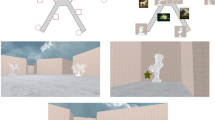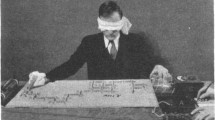Summary
In previous experiments with small animals, paramecia and mealworms followed the predictions of IR in their maze behavior while flatworms did not. In the present experiment, 300 undergraduate psychology students in general did behave largely as would be predicted by IR in a multisectional stylus maze. When the distance between a forced turn and a choice point was short (2 cm.), students turned in the direction opposite to that of the forced turn more often than chance would predict. In the longer distances, they did not turn in the predicted direction significantly more often than in the non-predicted direction with the single exception of the longest (18 cm.) distance in the one forced turn condition.
Similar content being viewed by others
References
ARBIT, J., & McLEAN, J. P. The spatial gradient of alternation and reactive inhibition in the earthworm. The Worm Runners Digest, 1961, 3, 18–20.
BALLACHEY, E. L., & BUEL, J. Centrifugal swing as a determinant of choice-point behavior in the maze running of the white rat. J. comp. Psychol., 1934, 17, 201–223.
BUEL, J., & BALLACHEY, E. L. Choice point expectancy in the maze running of the rat. J. genet. Psychol., 1934, 45, 145–168.
GROSSLIGHT, J. H., & TICKNOR, W. Variability and reactive inhibition in the meal worm as a function of determined turning sequences. J. comp. physiol.. Psychol., 1953, 46, 35–38.
HULL, C. L. Principles of behavior. New York: Appleton-Century, 1943.
LEPLEY, W., & RICE, G. E. Behavior variability in paramecia as a function of guided act sequences. J. comp. physiol. Psychol., 1952, 45, 283–286.
RICE, G. E. Behavior variability in paramecia; Investigation of time and distance factors. Pub. No. 7411, Pennsylvania State University, 1953 (Abstract)
RICE, G. E., & LAWLESS, R. H. Behavior variability and reactive inhibition in the maze behavior of planaria dorotocephala. J. comp. physiol. Psychol. 1957, 50, 105–108.
SCHNEIRLA, T. C. Learning and orientation in ants. Comp. Psychol. Monogr., 1929, 6, no. 4.
THOMPSON, M. E. Centrifugal swing or work inhibition as a factor in maze behavior. Amer. Psychologist, 1949, 4, 228 (Abstract).
Author information
Authors and Affiliations
Additional information
This study was done while both authors were at the University of Wichita.
Rights and permissions
About this article
Cite this article
Rice, G.E., Lawless, R.H. Behavior variability and reactive inhibition in human stylus maze behavior. Psychol Rec 11, 333–338 (1961). https://doi.org/10.1007/BF03393419
Published:
Issue Date:
DOI: https://doi.org/10.1007/BF03393419




